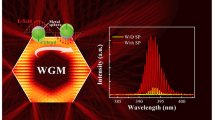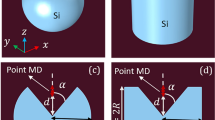Abstract
Here, we propose a hollow quasi-periodic spoof plasmonic structure to realize the ultrastrong Purcell enhancement of magnetic dipole emission in terahertz frequency range based on quasi-bound states in the continuum. By independently tuning the substructures, we can severally tune the responses of the electric dipole and quadripolar modes supported by groove-substructure, and the magnetic dipolar mode supported in slit-substructure. In particular, we also observe a whispering gallery mode supported by the composite structure, which will move with changing structural parameters. When the magnetic dipole mode close to the whispering gallery mode, the interference between them will emerge to generates a quasi-bound state in the continuum with ultra-high quality factor. Then, based on the quasi-periodic structure, we put a magnetic dipole into the hollow structure center and realize the ultrastrong Purcell enhancement of magnetic dipole emission, which can be more than 105. The designed structure can be applied to a variety of magneto-optical devices to greatly enhance Purcell effect in terahertz region.
Graphical Abstract
Manipulating the spontaneous emission rate of magnetic dipole with artificial magnetic resonators have been widely investigated to provide the road toward novel magnetic light-matter interactions. However, the emission strength of magnetic dipole still an open challenge due to the lack of high-quality factor cavity with magnetic dipole resonance. Here, we propose a hollow quasi-periodic spoof plasmonic structure to realize the ultrastrong Purcell enhancement of magnetic dipole emission in terahertz frequency range based on quasi-BIC as shown in (a). By independently tuning the substructures, we can severally tune the responses of the electric dipole and quadripolar modes supported by groove-substructure, and the magnetic dipolar mode supported in slit-substructure. Particularly, when the magnetic dipole close to the electric quadrupole, the interference between the magnetic dipolar mode as a bright one and electric quadrupolar modes as a dark one in the quasi-structure can generate a sharp Fano resonance with high quality factor. When we put a magnetic dipole into the structure center and realize the ultrastrong Purcell enhancement of magnetic dipole emission, which can be more than 105 as Figure (b). The designed structure can be applied to a variety of magneto-optical devices to greatly enhance magnetic Purcell effect in terahertz region.





Similar content being viewed by others
Data Availability Statement
This manuscript has no associated data or the data will not be deposited. [Authors' comment: The datasets generated during and/or analyzed during the current study are available from the corresponding author on reasonable request.]
References
S. Karaveli, R. Zia, Spectral tuning by selective enhancement of electric and magnetic dipole emission. Phys. Rev. Lett. 106(19), 193004 (2011)
R. Hussain, S.S. Kruk, C.E. Bonner, M.A. Noginov, I. Staude, Y.S. Kivshar, N. Noginova, D.N. Neshev, Enhancing Eu 3+ magnetic dipole emission by resonant plasmonic nanostructures. Opt. Lett. 40(8), 1659–1662 (2015)
J. Xiang, J.D. Chen, S. Lan, A.E. Miroshnichenko, Nanoscale optical display and sensing based on the modification of Fano lineshape. Adv. Opt. Mater. 8(16), 2000489 (2020)
J.Q. Li, N. Verellen, P.V. Dorpe, Engineering electric and magnetic dipole coupling in arrays of dielectric nanoparticles. J. Appl. Phys. 123(8), 083101 (2018)
N. Bontempi, K.E. Chong, H.W. Orton, I. Staude, D.Y. Choi, I. Alessandri, Y.S. Kivshar, D.N. Neshev, Highly sensitive biosensors based on all-dielectric nanoresonators. Nanoscale 9(15), 4972–4980 (2017)
R. Terawaki, Y. Takahashi, M. Chihara, Y. Inui, S. Noda, Ultrahigh-Q photonic crystal nanocavities in wide optical telecommunication bands. Opt. Express 20(20), 22743–22752 (2012)
S. AbdollahRamezani, K. Arik, A. Khavasi, Z. Kavehvash, Analog computing using graphene-based metalines. Opt. Lett. 40(22), 5239–5242 (2015)
S. AbdollahRamezani, K. Arik, S. Farajollahi, A. Khavasi, Z. Kavehvash, Beam manipulating by gate-tunable graphene-based metasurfaces. Opt. Lett. 40(22), 5383–5386 (2015)
Y.H. Fu, A.I. Kuznetsov, A.E. Miroshnichenko, Y.F. Yu, B. Luk’yanchuk, Directional visible light scattering by silicon nanoparticles. Nat. Commun. 4(1), 1–6 (2013)
G.M. Akselrod, C. Argyropoulos, T.B. Hoang, C. Ciracì, C. Fang, J.N. Huang, D.R. Smith, M.H. Mikkelsen, Probing the mechanisms of large Purcell enhancement in plasmonic nanoantennas. Nat. Photonics 8(11), 835–840 (2014)
W. Wei, X. Yan, X. Zhang, Ultrahigh Purcell factor in low-threshold nanolaser based on asymmetric hybrid plasmonic cavity. Sci. Rep. 6(1), 1–7 (2016)
S.R. Joy, M. Erementchouk, P. Mazumder, Spoof surface plasmon resonant tunneling mode with high quality and Purcell factors. Phys. Rev. B 95(7), 075435 (2017)
W. Liu, A.E. Miroshnichenko, R.F. Oulton, D.N. Neshev, O. Hess, Y.S. Kivshar, Scattering of core-shell nanowires with the interference of electric and magnetic resonances. Opt. Lett. 38(14), 2621–2624 (2013)
Z.G. Dong, H. Liu, M.X. Xu, T. Li, S.M. Wang, S.N. Zhu, X. Zhang, Plasmonically induced transparent magnetic resonance in a metallic metamaterial composed of asymmetric double bars. Opt. Express 18(17), 18229–18234 (2010)
B. Choi, M. Iwanaga, Y. Sugimoto, K. Sakoda, H.T. Miyazaki, Selective plasmonic enhancement of electric-and magnetic-dipole radiations of Er ions. Nano Lett. 16(8), 5191–5196 (2016)
S.M. Hein, H. Giessen, Tailoring magnetic dipole emission with plasmonic split-ring resonators. Phys. Rev. Lett. 111(2), 026803 (2013)
T.H. Feng, Y. Xu, Z.X. Liang, W. Zhang, All-dielectric hollow nanodisk for tailoring magnetic dipole emission. Opt. Lett. 41(21), 5011–5014 (2016)
M. Sanz-Paz, C. Ernandes, J.U. Esparza, G.W. Burr, N.F. Hulst, A. Maitre, L. Aigouy, T. Gacoin, N. Bonod, M.F. Garcia-Parajo, S. Bidault, M. Mivelle, Enhancing magnetic light emission with all-dielectric optical nanoantennas. Nano Lett. 18(6), 3481–3487 (2018)
J.Q. Li, N. Verellen, P.V. Dorpe, Enhancing magnetic dipole emission by a nano-doughnut-shaped silicon disk. ACS Photonics 4(8), 1893–1898 (2017)
P. Albella, M.A. Poyli, M.K. Schmidt, S.A. Maier, F. Moreno, J.J. Sáenz, J. Aizpurua, Low-loss electric and magnetic field-enhanced spectroscopy with subwavelength silicon dimers. Phys. Chem. C 117(26), 13573–13584 (2013)
D.G. Baranov, R.S. Savelev, S.V. Li, A.E. Krasnok, A. Alù, Modifying magnetic dipole spontaneous emission with nanophotonic structures. Laser Photon. Rev. 11(3), 1600268 (2017)
A.B. Evlyukhin, S.M. Novikov, U. Zywietz, R.L. Eriksen, C. Reinhardt, S.I. Bozhevolnyi, B.N. Chichkov, Demonstration of magnetic dipole resonances of dielectric nanospheres in the visible region. Nano Lett. 12(7), 3749–3755 (2012)
E. Lee, I.C. Seo, H.Y. Jeong, S.C. An, Y.C. Jun, Theoretical investigations on microwave Fano resonances in 3D-printable hollow dielectric resonators. Sci. Rep. 7(1), 1–10 (2017)
H. Mi, L. Wang, Y.P. Zhang, G.T. Zhao, R.B. Jiang, Control of the emission from electric and magnetic dipoles by gold nanocup antennas. Opt. Express 27(10), 14221–14230 (2019)
H.W. Wu, Y.Z. Han, H.J. Chen, Y. Zhou, X.C. Li, J. Gao, Z.Q. Sheng, Physical mechanism of order between electric and magnetic dipoles in spoof plasmonic structures. Opt. Lett. 42(21), 4521–4524 (2017)
H.W. Wu, H.J. Chen, H.F. Xu, R.H. Fan, Y. Li, Tunable multiband directional electromagnetic scattering from spoof Mie resonant structure. Sci. Rep. 8(1), 1–8 (2018)
H.W. Wu, Y. Li, H.J. Chen, Z.Q. Sheng, H. Jing, R.H. Fan, R.W. Peng, Strong Purcell effect for terahertz magnetic dipole emission with spoof plasmonic structure. ACS Appl. Nano Mater. 2(2), 1045–1052 (2019)
H.W. Wu, J.Q. Quan, Y.Q. Yin, Z.Q. Sheng, Strong Purcell effect for magnetic dipole emission with spoof plasmonic spiral structure. J. Opt. Soc. Am. B 37(1), 98–103 (2020)
H.M. Doeleman, E. Verhagen, A.F. Koenderink, Antenna–cavity hybrids: matching polar opposites for Purcell enhancements at any linewidth. ACS Photonics 3(10), 1943–1951 (2016)
R.V. Mikhaylovskiy, T.J. Huisman, R.V. Pisarev, T. Rasing, A.V. Kimel, Selective excitation of terahertz magnetic and electric dipoles in Er 3+ ions by femtosecond laser pulses in ErFeO3. Phys. Rev. Lett. 118(1), 017205 (2017)
Acknowledgements
Hong-Wei Wu thanks the supports of the National Natural Science Foundation of China (NSFC) (Grant No. 11904008); the Natural Science Foundation of Anhui Province (Grant No. 1908085QA21); and the China Postdoctoral Science Foundation (Grant No. 2019M662132).
Author information
Authors and Affiliations
Contributions
All authors contributed to the study conception and design. Material preparation, data collection and analysis were performed by Hong-Wei Wu, Shu-Ling Cheng and Yun-Qiao Yin. The first draft of the manuscript was written by Shu-Ling Cheng and all authors commented on previous versions of the manuscript. All authors read and approved the final manuscript.
Corresponding author
Rights and permissions
Springer Nature or its licensor (e.g. a society or other partner) holds exclusive rights to this article under a publishing agreement with the author(s) or other rightsholder(s); author self-archiving of the accepted manuscript version of this article is solely governed by the terms of such publishing agreement and applicable law.
About this article
Cite this article
Cheng, SL., Wu, HW. & Yin, YQ. Ultrastrong Purcell enhancement of magnetic dipole emission based on quasi-BIC. Eur. Phys. J. D 76, 211 (2022). https://doi.org/10.1140/epjd/s10053-022-00543-y
Received:
Accepted:
Published:
DOI: https://doi.org/10.1140/epjd/s10053-022-00543-y




